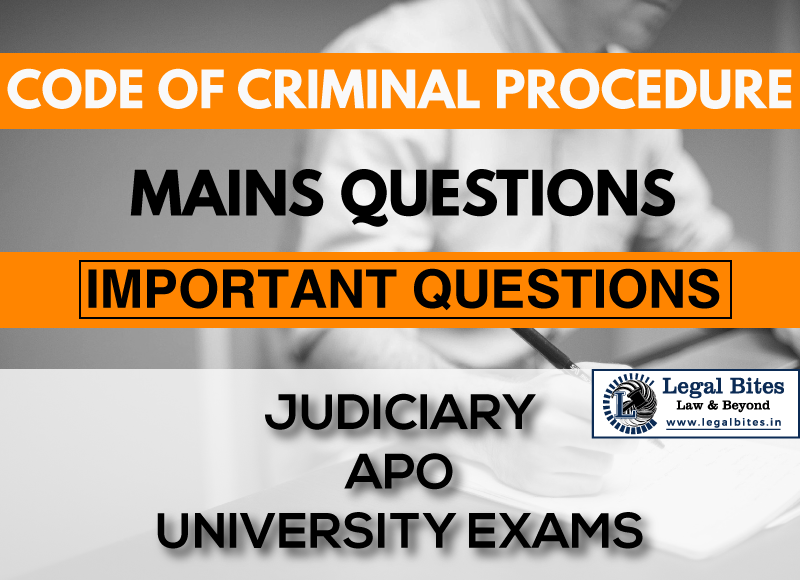Whether trial of more than three offences at one trial committed within a year is ‘irregular’ or ‘illegal’? Give reasons and refer to the case law in support of your reason.
Question: Whether trial of more than three offences at one trial committed within a year is ‘irregular’ or ‘illegal’? Give reasons and refer to the case law in support of your reason. Find the answer only on Legal Bites. [Whether trial of more than three offences at one trial committed within a year is ‘irregular’ or ‘illegal’? Give… Read More »

Question: Whether trial of more than three offences at one trial committed within a year is ‘irregular’ or ‘illegal’? Give reasons and refer to the case law in support of your reason. Find the answer only on Legal Bites. [Whether trial of more than three offences at one trial committed within a year is ‘irregular’ or ‘illegal’? Give reasons and refer to the case law in support of your reason.] Answer Section 218 of the Code of Criminal Procedure Code, 1973 lays down the...
Question: Whether trial of more than three offences at one trial committed within a year is ‘irregular’ or ‘illegal’? Give reasons and refer to the case law in support of your reason.
Find the answer only on Legal Bites. [Whether trial of more than three offences at one trial committed within a year is ‘irregular’ or ‘illegal’? Give reasons and refer to the case law in support of your reason.]
Answer
Section 218 of the Code of Criminal Procedure Code, 1973 lays down the basic rule of charge and trial. The basic rule states that there must be a different and separate charge for every offence that the person is accused of and every charge levied against the person shall be tried separately in distinct trials.
Section 219 of the Code of Criminal Procedure, 1973
Three offences of the same kind within a year may be charged together in the following manner:
(1) When a person is accused of more offences than one of the same kind committed within the space of twelve months from the first to the last of such offences, whether in respect of the same person or not, he may be charged with, and tried at one trial for, any number of them not exceeding three.
(2) Offences are of the same kind when they are punishable with the same amount of punishment under the same section of the Indian Penal Code (45 of 1860 ) or of any special or local law.
This section modifies section 218 by allowing three charges of three offences of the same kind committed within one year to be tried together. It limits the number of charges of the same kind which may be tried in a single trial. The accused may be tried separately for other offences.
The Privy Council in Subramania Iyer v. King-Emperor, (1901) 28 Moo Ind App 257 has ruled that it is illegal under this section to charge a person at one trial with more than three acts, these acts extending over a period of more than a year. In this case, the accused was tried on charges of extortion in which forty-one criminal acts extending over a period of two years were brought against him. It was held that the trial so conducted was plainly prohibited and was illegal and could not be cured by section 464.
In ‘Raman Lal v. Emperor‘, AIR 1927 All 223 (Z), Raman Lal’s trial for more than three offences of Section 408 committed in several transactions spreading over a period of more than one year was held to be illegal.
Important Mains/Long Questions for Judiciary, APO & University Exams
- CRPC Mains Questions Series Part I: Important Questions
- CRPC Mains Questions Series Part II: Important Questions
- CRPC Mains Questions Series Part III: Important Questions
- CRPC Mains Questions Series Part IV: Important Questions
- CRPC Mains Questions Series Part V: Important Questions
- CRPC Mains Questions Series Part VI: Important Questions
- CRPC Mains Questions Series Part VII: Important Questions
- CRPC Mains Questions Series Part VIII: Important Questions
- CRPC Mains Questions Series Part IX: Important Questions
- CRPC Mains Questions Series Part X: Important Questions
- CRPC Mains Questions Series Part XI: Important Questions
Admin Legal Bites
Legal Bites Study Materials correspond to what is taught in law schools and what is tested in competitive exams. It pledges to offer a competitive advantage, prepare for tests, and save a lot of money.
